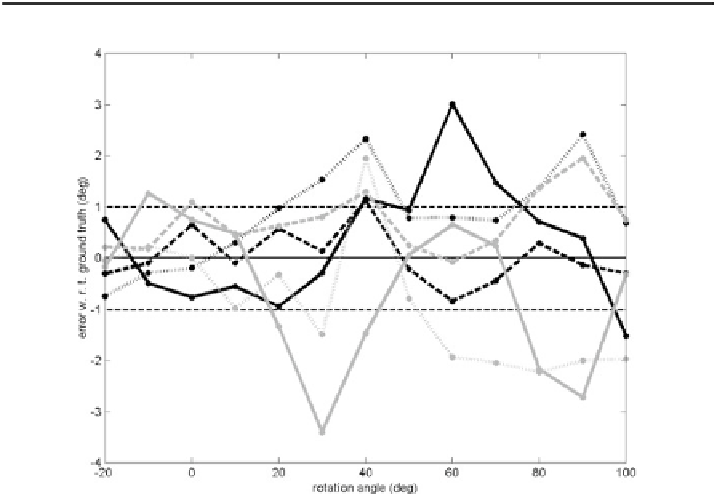Graphics Reference
In-Depth Information
Ta b l e 6 . 1
Properties of the three oil cap template hierarchies (ranges of pose angles
ρ
,
ε
,
λ
,
and grid sizes in degrees). Hierarchy 1 consists of 4550 templates, hierarchies 2 and 3 of 1331
templates, respectively
Hierarchy
ρ
range
ρ
ε
range
ε
λ
range
λ
0
◦
...
180
◦
2
◦
18
◦
...
72
◦
6
◦
12
◦
...
12
◦
6
◦
1
−
+
0
◦
...
20
◦
2
◦
30
◦
...
50
◦
2
◦
10
◦
...
10
◦
2
◦
2
−
+
3
Same as 2, but without writing modelled
Fig. 6.2
Deviations of
ε
(
solid lines
),
ρ
(
dashed lines
), and
λ
(
dotted lines
) from their ground truth
values. Illumination is with cylindric lamp only (
black lines
) and with both cylindric and halogen
lamps (
grey lines
). The true roll angle is constantly set to
ε
70
◦
=
camera lens (confocal illumination) and a halogen spot. The background of the
scene may be fairly cluttered. The distance to the object amounts to 200 mm and
is assumed to be known, such that only five degrees of freedom are to be es-
timated. The resolution of the utilised images corresponds to about 0
.
4 mm per
pixel.
For this examination we use template hierarchy 1 (cf. Table
6.1
). The angle
ε
de-
notes the roll angle,
λ
the pitch angle, and
ρ
the yaw angle. For camera viewpoints
with
10
◦
≤
10
◦
and 50
◦
≤
60
◦
, the measured pose lies within the calibra-
−
ρ
≤
ε
≤
tion accuracy interval of 1
◦
70
◦
,
for all three angles. Figure
6.2
shows that for
ε
=
20
◦
. This implies that from a correspondingly cho-
sen viewpoint, the algorithm is highly sensitive with respect to deviations from the
reference pose. Hence, it is possible to determine the pose of the oil cap to an ac-
curacy of about 1
◦
. Significantly changing the illumination conditions by switching
20
◦
≤
this is even true for
−
ρ
≤



Search WWH ::

Custom Search